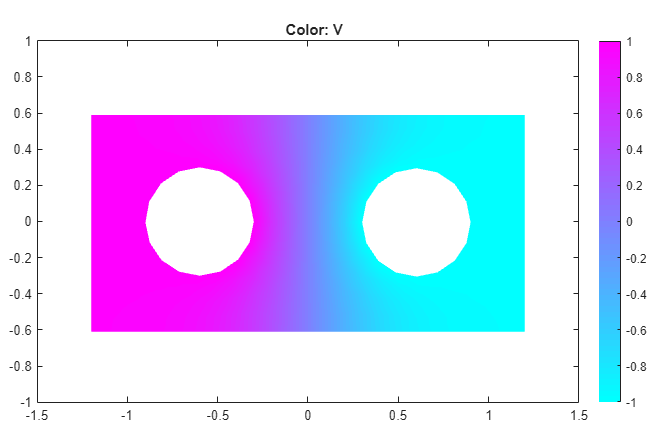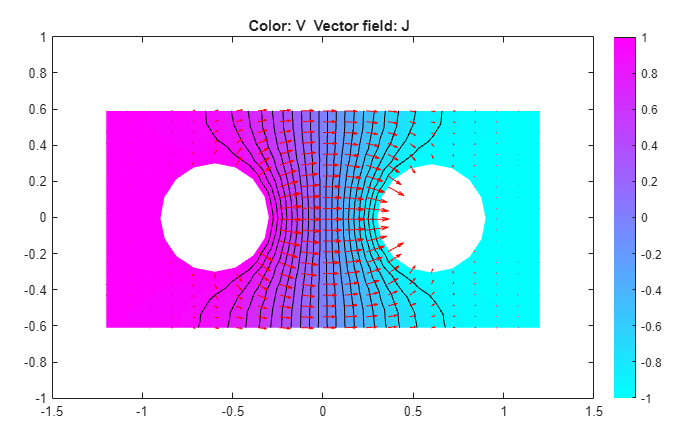Current Density Between Two Metallic Conductors: PDE Modeler App
Two circular metallic conductors are placed on a brine-soaked blotting paper which serves as a plane, thin conductor. The physical model for this problem consists of the Laplace equation
–∇ · (σ∇V) = 0
for the electric potential V and these boundary conditions:
V = 1 on the left circular conductor
V = –1 on the right circular conductor
the natural Neumann boundary condition on the outer boundaries
The conductivity is σ = 1.
To solve this equation in the PDE Modeler app, follow these steps:
Model the geometry: draw the rectangle with corners at (-1.2,-0.6), (1.2,-0.6), (1.2,0.6), and (-1.2,0.6), and two circles with a radius of 0.3 and centers at (-0.6,0) and (0.6,0). The rectangle represents the blotting paper, and the circles represent the conductors.
pderect([-1.2 1.2 -0.6 0.6]) pdecirc(-0.6,0,0.3) pdecirc(0.6,0,0.3)
Model the geometry by entering
R1-(C1+C2)in the Set formula field.Set the application mode to Conductive Media DC.
Specify the boundary conditions. To do this, switch to the boundary mode by selecting Boundary > Boundary Mode. Use Shift+click to select several boundaries. Then select Boundary > Specify Boundary Conditions.
For the rectangle, use the Neumann boundary condition with
g = 0andq = 0.For the left circle, use the Dirichlet boundary condition with
h = 1andr = 1.For the right circle, use the Dirichlet boundary condition with
h = 1andr = -1.
Specify the coefficients by selecting PDE > PDE Specification or clicking the
 button on the toolbar. Specify
button on the toolbar. Specify sigma = 1andq = 0.Initialize the mesh by selecting Mesh > Initialize Mesh.
Refine the mesh by selecting Mesh > Refine Mesh.
Improve the triangle quality by selecting Mesh > Jiggle Mesh.
Solve the PDE by selecting Solve > Solve PDE or clicking the
 button on the toolbar. The resulting potential is
zero along the y-axis, which, for this problem, is a vertical
line of antisymmetry.
button on the toolbar. The resulting potential is
zero along the y-axis, which, for this problem, is a vertical
line of antisymmetry.
Plot the current density J. To do this:
Select Plot > Parameters.
In the resulting dialog box, select the Color, Contour, and Arrows options.
Set the Arrows value to
current density.
The current flows, as expected, from the conductor with a positive potential to the conductor with a negative potential. The conductivity σ is isotropic, and the equipotential lines are orthogonal to the current lines.
